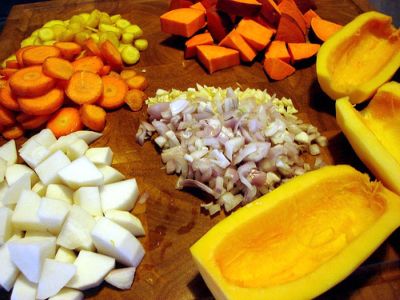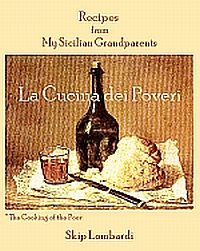Tracking Turkey 2010
November 22nd, 2010
apple, what might you not have done for a truffled turkey?”
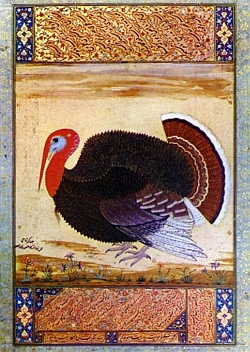
In the late 18th century, shortly after the founding of the United States of America, the statesman Benjamin Franklin wrote to his daughter:
“I wish the Bald Eagle had not been chosen as the Representative of the Country; he is a Bird of bad moral Character, like those among Men who live by Sharping and Robbing, he is generally poor and often very lousy…The Turkey is a much more respectable Bird, and withal a true original Native of America.” (1)
No stranger to the pleasures of the table, Ben Franklin was doubtless well acquainted with the wild turkey, a game bird indigenous to North and Central America.
In considering these birds, I would like, first of all, to deal with the English noun “turkey.” Unabashedly, I confess it to be my inspiration for this paper, which I first delivered in the country of the same name.
The most convincing etymological sources (2) speak of fowl known as “turkey cocks” in reference to large domesticated birds (provably of the genus Pavo). By mid-16th century “Guinea hens” were synonymous with “turkey-cocks” and referred to fowl of African origin. Some of these were supposed to have been brought from West Africa (Guinea) and others from Numidia via the Turkish dominions, hence the name “turkey.” Sixteenth century Spanish explorers in Mexico found that the Aztecs had domesticated a large fan-tailed bird, the huexolotl, which was prized for its meat and regularly offered as tribute to the Aztec monarch, Montezuma. The Spaniards introduced this bird to Europe, where the confusion over its name began.
For those of you who like to know the origins of words you eat, here is a brief summary of what happened to the feathered pride of the Aztecs:
The Spaniards called the new bird pavo, after the European fowls they knew.The French, considering the bird to be from the general Caribbean region called the creature poule d’Indes, or dinde, after the Caribbean islands Columbus had mistaken for India, and which we call the West Indies. Later, in provincial areas of France, the birds were sometimes known as jusites after Jesuit brothers who started a turkey farm near Bourges. (3)
Linnaeus, the great Swedish classifier, mistakenly gave the New World creature the Latin name that rightfully belonged to the Old World fowl, Meleagris gallopavo. Thus, something else (Numida meleagris) had to be concocted for the turkey-cock. (Meleagris means speckled.) (4)
The English called it turkey because it was closer in appearance to their turkey-cocks that to anything else they’d seen. The Turks, probably to agree with the French, or maybe because they thought it inappropriate to roast a creature named for their nation, chose to call the bird hindi, thus pushing matters farther east.
Meanwhile, the Portuguese preferred to go west. Sources mention that they wrongly supposed the bird to have come from Peru. To this day, Portuguese speakers from Brazil to Goa call the bird peru. And thanks to Portuguese trade with India, the Hindi name for turkey is piru.
The Arabs took their own word for cockerel, dik, and added the Arabic adjective pertaining to Turkey or Asia Minor, rumi, which referred back to the Byzantine Empire, of the Land of Rome. Thus, dik rumi, an Arab turkey, is really a Roman rooster.
But it is none other than the wild Meleagris gallopavo that American folklore has solidly established itself as one of the native foods enjoyed by the Puritan colonists of Massachusetts when they celebrated their first Thanksgiving in 1621. That feast was, by all accounts, a prayerful occasion during which the English pilgrims thanked their Savior for a safe flight from religious persecution in England and for the bounty of their first harvest in the New World.
To properly appreciate turkey’s place within the cuisine of the United States, one must look briefly at the development of our holiday commemorating the Pilgrims. As a feast-day, it was not an instant success. After that initial Pilgrim banquet, over two centuries would pass before Thanksgiving, the most “typically American” of celebrations, was officially decreed a national holiday.
Beginning in the 1820’s, Mrs. Sarah Josepha Hale, the editor of an influential women’s magazine, Godey’s Lady’s Book, carried on a patriotic crusade for the establishment of Thanksgiving as a national holiday. She wrote hundreds of editorials and letters urging politicians, clergymen and the readers of her periodical to lobby for this cause. Finally, in 1863 in the midst of the American Civil War and shortly after the Northern Army’s victory at Gettysburg, the combination of Mrs. Hale’s annual exhortations and the Northern desire to celebrate its triumph prompted President Lincoln to proclaim the third Thursday in November as the national day of Thanksgiving. As early as 1857, Mrs. Hale filled the cookery pages of the November issue of Godey’s with recipes for roast turkey and other dishes to be served at the Thanksgiving meal. Despite myriad changes in food technology, taste, and society since then, American magazine and newspaper food editors still adhere to Mrs. Hale’s basic format.
Mrs. Hale and President Lincoln may have assured the seasonal demand for turkey, but so plentiful were the wild turkeys that turkey breeding for superior flesh did not attract significant commercial interest until the 20th century. Earlier American turkey breeders had concentrated on the production of large feathers deemed essential for Victorian womens’ hats and fans. (5)
While the fashion for turkey plumes may have subsided, the cooking of turkeys continued to be a subject of much discussion and divergent opinion. In “Statesmen’s Dishes and How to Cook Them” (1890), Mrs. Stephen J. Field suggested that “three days before [a turkey] is slaughtered, it should have an English walnut forced down its throat three times a day and a glass of sherry once a day. The meat will be deliciously tender and have a fine nutty flavor.” (6) An eighteenth century adventurer in the American Midwest extolled the merits of stewing a turkey in racoon fat. (7)
Currently, one highly successful processor of oven-ready turkeys advertises birds that are “self-basting.” Its raw turkeys are injected with corn oil to keep the meat from becoming too dry. Many of these turkeys are also equipped with heat-sensitive devices that indicate precisely when the bird is done to perfection.
Though its stuffings of bread-crumbs and herbs, nuts and dried fruits, sausage meat or oysters vary widely from kitchen to kitchen, a roast turkey is an essentially simple affair. It is no surprise that in the American idiom, “to talk turkey” means to speak plainly and directly, to deal with the basics. Hence one well-known firm’s “Turkey-Talk Line,” a toll-free telephone assistance service which operates from a few weeks before Thanksgiving through the Christmas-New Year holidays. Despite innovations such as birds with embedded thermometers, the firm receives thousands of calls from distraught, once-a-year turkey chefs who prove that “fool-proof” is a relative term. Panic frequently arises when a consumer has neglected to remove the bird’s plastic wrapping before placing it in the oven or has forgotten to turn the oven on until half an hour before dinner is to be served to a dozen guests.
Sentiments about Thanksgiving are strong. And since a superabundance of family members and food are what characterize the celebration for most Americans, it is not surprising that there is a collective attachment to family food traditions. This tends to discourage avant-garde experimentation. Turkeys stuffed with couscous or accompanied by a kiwi chutney do appear in magazines, but by and large, most Americans cooking for their families are unlikely to tamper with tradition at Thanksgiving. Though few would dispute the festiveness of a fine rack of lamb or a magnificent bouillabaisse, few Americans would seriously consider either suitable Thanksgiving fare. (8)
By virtue of its iconic role in the Thanksgiving dinner, turkey has become an American symbol—not so much to non-Americans, who may associate the United States with beef cattle, great grain fields, and fast food—but by Americans themselves.
Unofficially, at least, the bird with the ugly head and the spectacular plumage eventually achieved some of the status Ben Franklin begrudged the eagle. During World War II, extraordinary measures were taken to ensure that American troops overseas, and even those fighting on the front lines, were given hot turkey dinners on Thanksgiving Day. (9) & (10)
Oddly, mass popularity has not diminished wealthy or fad-following Americans’ appetite for turkey. It continues to be a meat for feasts even as improved farming has made it plentiful and cheap enough to be used instead of beef or pork scraps in sausages and hot dogs. And lean, freshly ground turkey, sold alongside ground beef in supermarkets the year round, carries no message of either Pilgrim piety or holiday largesse. More often than not, it is simply labeled “low-cholesterol.”
Despite advertising’s transformation of turkey into an inexpensive “health food,” a browned, well-basted roast turkey is in no danger of being supplanted as the centerpiece of our holiday devoted to unabashed gluttony. But what irony that the turkey (albeit stripped of its flavorful, fattening skin) should also epitomize prudent restraint for body-conscious Americans today. What would the Pilgrims think?
— Holly Chase
Notes & Bibliography
(1) The American Heritage Cookbook and Illustrated History of American
Eating and Drinking, American Heritage Publishing Co., 1964; p. 482.
(2) The Oxford English Dictionary, second edition.
(3) Larousse Gastronomique (English edition), Crown Publishers, New
York, 1964.
(4) The Oxford English Dictionary.
(5) The Thansgiving Book, by Lucille Recht Penner (Hastings House, New
York, 1996), p. 115.
(6) See note 1, p. 483
(7) The Wild Turkey: Its History & Domestication, by A.W. Schorger
(University of Oklahoma Press, Norman, Okla; 1966, pp. 370-1). An
entertaining blend of exhaustive research and superior writing– food
scholarship at its zenith.
(8) When “new” dishes enter the Thanksgiving repertoire, food writers tend to link them to earlier American traditions. And America, at least in the geographical sense, certainly includes Mexico, source of the turkey. Yet I know of no proposals to add two especially splendid Mexican turkey recipes to the Thanksgiving table.
The first Spaniards in Mexico wrote that the Aztecs ate turkey with a sauce based on bitter chocolate, the ancestor of today’s mole poblano, a seductive poultry sauce from the Mexican state of Puebla. And then there is pavo en escabeche, stewed turkey marinated in oil, vinegar, herbs and onions—a dish with obvious Mediterranean antecedents.
(9) Thanksgiving: An American Holiday, An American History, by Diana Karter Applebaum (Facts on File Publications, New York and Bicester, England, 1985); pp. 249-250.
(10) The most typical “trimmings” would include a sage and bread stuffing, mashed potatoes, giblet gravy, cranberry relish, creamed onions and fresh celery.
How to Host Thanksgiving Dinner (And Enjoy it Anyway)
October 7th, 2009You’ve been nominated. Perhaps your family has issued a decree. Or maybe, it’s simply your turn. No matter what the reason, you’re hosting Thanksgiving dinner next week. This need not be a burden. In fact, given the right planning and organization, orchestrating Thanksgiving dinner can be a pleasure.
I’ve found that the key to the successful dinner is thinking backwards. Start your Thanksgiving planning by visualizing yourself surrounded by family and friends at the dinner table, then rewind your mental video to determine how you got there. Ask yourself which foods took the least amount of preparation, which took the most. Write these things down. Make a list.
Now, add a little detail to the list to remind yourself which dishes can be prepared the day (or evening) before. Which dishes need to be prepared Thanksgiving Day? Which must be prepared within an hour of dinner?
At this point, you will have at least a vague idea for your plan of attack. So now it’s time to further refine the list. In fact, it’s time to begin to create a schedule. For example, if you intend to serve dinner at 2:00 p.m., and have calculated that the turkey will take three hours to roast, and half hour to rest before carving, the bird needs to be in the oven at 10:00 a.m.
Why 10:00, and not 10:30? In addition to the three and a half hours for roasting and resting, I’ve factored in 15 minutes to pre-heat the oven, and 15 minutes to carve the bird and arrange it on a serving platter. Your schedule should reflect all of these variables.
By now, your initial list has probably become three or four lists as you prioritize the steps leading to that wonderful image of yourself sitting among family and friends at the table. The next stage in the process is to identify the tasks involved in readying the ingredients for individual dishes: the prep work.
How lovely to watch a rock star chef on Food TV blithely talking about adding a cup of chopped onions to a sauté pan, as her perfectly manicured hand reaches across an Italian granite counter to retrieve a cup of chopped onions. Of course, TV chefs have the benefit of having four sous-chefs backstage who keep them supplied with all the chopped, minced, pureed, ground, or marinated ingredients they’ll need to create a smooth-running half-hour television show. You, too, can enjoy having these things prepped in advance (although you probably can’t count on having the four sous-chefs backstage).
As part of your master schedule, allow plenty of time for prep work. This will greatly reduce any cooking anxieties. You do not want to be hunting for a clove of garlic in a refrigerator stuffed with food for twenty while you have a pan of hot oil waiting for you on the stove.
Now is also the time to think about how many of the recipes on your menu will require the same ingredients. If, for example, you have two dishes on your menu, each requiring a cup of chopped onions, be sure to chop two cups of onions to have on hand, pre-measured and ready to go when the time comes to cook. Try to think of other ingredients that can also be prepped early: have winter squash that can be peeled and cubed? Brussels sprouts to be trimmed and scored?
One task that you can check off now, days before Thanksgiving, is making sure your oven is properly calibrated. If you don’t already own one, get an inexpensive oven thermometer. Test to see if the temperature you set on your oven thermostat is indeed what is displayed on your thermometer. If your oven’s temperature does not match your control thermometer, you’ll know in advance that you’ll have to compensate, setting the oven temperature a little higher or lower. You don’t want burned pie crust or underdone potatoes.
In addition, it would be wise—again, if you don’t already have one—to get an instant-read meat thermometer for your turkey. Knowing that you’ve cooked your turkey to an internal temperature of 165 F. will give you a great deal of confidence and allow you to focus on the myriad last-minute details of getting the meal to the table.
One last comment about prep work that will make the entire Thanksgiving experience more enjoyable: give yourself a break when you’ve finished chopping vegetables, measuring ingredients, and generally assuring yourself that you have the situation in hand. Relax, perhaps with a cup of coffee or a glass of wine ,before you begin the actual cooking.
This break provides a peaceful interlude and helps you to mentally shift gears, to move from the self-supporting role of prep cook to the grander role chef de cuisine.
Of course, at some time before Thanksgiving, you’ll need to shop for ingredients. I’ve not spoken about shopping, because I feel there are too many variables. Factors such as your menu, proximity to a mega-store or specialized deli, your work schedule, etc. make it difficult to talk about provisioning in universal terms. Suffice it to say that if you can plan a menu and create a schedule, you’ll know what you need, and when.
So, menu set, shopping and prep work done, what do you do on Thanksgiving morning? First of all–trust no one. People are rarely more giving of themselves than at Thanksgiving, and offers to assist in the kitchen will be impassioned and extravagant. Be wary, be very wary. Should you delegate the creamed spinach details to a close friend or relative, don’t be surprised if Macy’s parade or the NFL game distracts your well-meaning helper and leaves you with lumpy bèchamel for your spinach.
But it’s okay. You’ve factored that into your schedule, and, you, the unflappable you, can pick up the slack. When I say that you shouldn’t trust anyone, I mean that—as I’ve written elsewhere—90% of cooking is simply being there.
Finally, at times like Thanksgiving, I’m reminded of a piece of advice I got from a doctor friend: in case of an emergency, the first thing to do is take your own pulse. While things may not go entirely as planned, you need not panic. Wholly dependable or not, help will be at hand. An emergency in the kitchen is guaranteed to draw the most hardened NFL fan away from the game to lend support. Just stick to your schedule as best you can. Everything will be fine.
Thoughtful advance planning of your Thanksgiving meal will pay off at the dinner table; you’ll reap compliments and maybe even a round of applause from happy, thankful diners. As you dry the last of the pots and pans that served so well in preparing your feast, you can savor the ultimate satisfaction that comes from a job well done and the comforting knowledge that, next year, it will be someone else’s turn.
Three entertaining—and maybe useful resources:
The Butterball Hotline
Susan Stamberg’s Mother’s Cranberry Relish
Green Bean Casserole
[ad#bottom]
Catch of the Day
August 4th, 2009Here in southeastern Connecticut where we spend our summers, Gambardella Seafood on the docks in Stonington nearly always has something good on offer when we drop in for a visit. But once in a while—as you can see below—we arrive to find them offloading a fishing boat that had just pulled up to their dock.
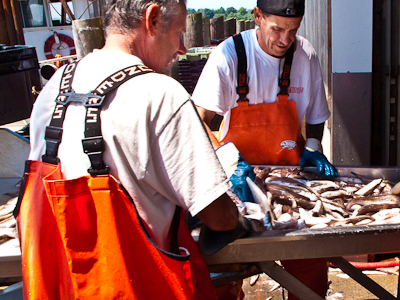
On this day, the catch was Whiting. Ordinarily not the most flavorful fish in the hold, we gave them a boost with lemon, olive oil, garlic, and red onion.
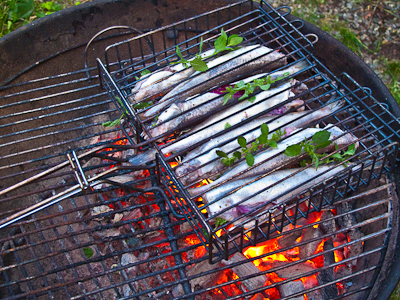
Following the marinade, we placed the fish on a bed of grape leaves and lemon balm and grilled them over hardwood charcoal. They completed their one-way trip from the Atlantic Ocean to our dinner table in slightly less than eight hours.
We don’t get to do that in Sarasota.
Jamie Oliver on NPR Today
November 23rd, 2008Jamie Oliver, best known as the British Naked Chef, visited NPR’s Weekend Edition this Sunday morning.
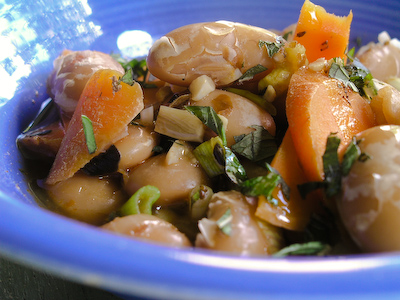
Sharing his thoughts on food frugality as they apply to Thanksgiving, he really got our attention when he pointed out that we live in a time when millions who need to watch their food costs have no idea how to prepare simple meals. In Western cultures where fast foods have been a feature for more than a generation, the need for people to know how to select and cook food and to rediscover the satisfaction of sharing meals has never been greater.
We’ve been saying the same things around our own tables (with family, friends, and our cooking class participants) for years.
We’ll be happy if the message begins to get across, thanks to the propulsion of Mr. Oliver’s outspoken celebrity. Most of all, we hope that the incoming administration’ s Secretary of Health and Human Services picks up the signal. Mr Obama’s own half-hour infomercial featured several constituents who were obese. They were everyday Americans whose financial constraints and health conditions could be bettered through dietary changes and more informed food preparation.
No matter who delivers it—the message is far more important than the messenger.
